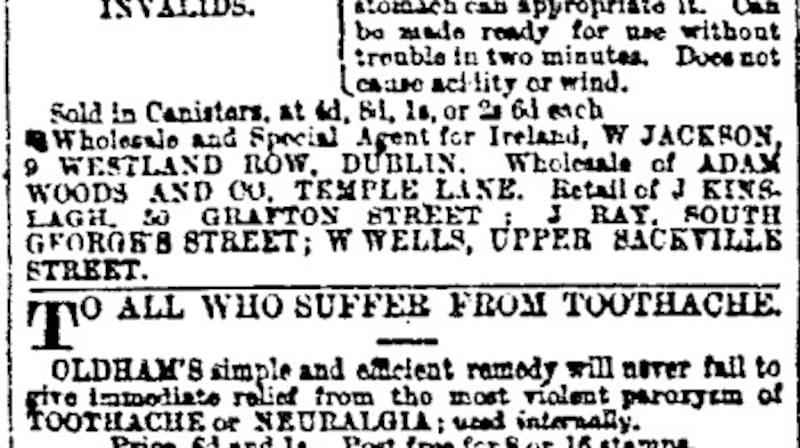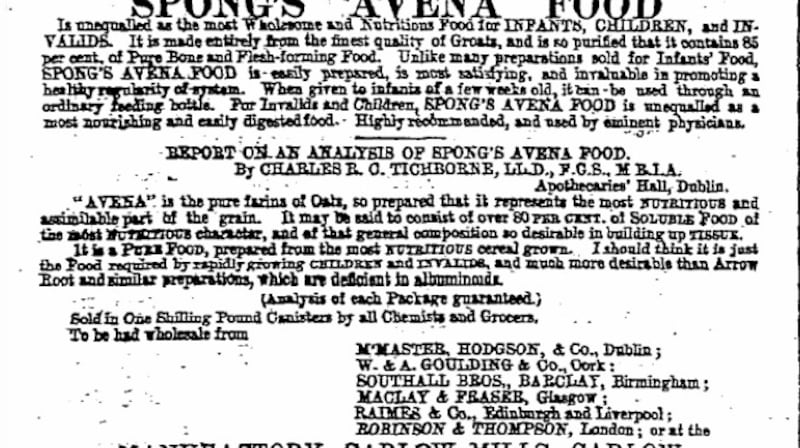The idea of invalid cookery has long vanished from most sickrooms and hospitals, but it was once a popular topic for newspaper columns and books, a module in nurse training, and a course subject at technical institutes. When the Women's National Health Association held tuberculosis exhibitions during 1908 and 1909, it included invalid cookery demonstrations, and some hotels offered an invalid diet to guests.

Children of the 1960s and ’70s will remember ads for Lucozade and Complan targeted at the sick and convalescing, but the marketing of foods and drinks to the ill and ailing has a long and, sometimes, insalubrious history.
In the year this paper launched, 1859, Bewleys, Evans & Co informed readers that its ginger wine “is a valuable stomachic, and peculiarly adapted for invalid and family use”.
Wine merchants such as E Champavert, meanwhile, recommended their wines and brandies for invalids, “as they are perfectly pure”, while by 1866 Guinness’s XXX Porter was being “specially ordered to invalids for its nutritional and strengthening qualities”.
Reports from Switzerland in 1867 even informed the less fortunate Irish that the poorest of cholera patients there were being prescribed champagne.
Another effervescent liquid remedy enjoyed in the 19th century was, “The Blood Purifer: Old Dr Jacob Townsend’s Sarsaparilla” which promised: “in a short time the suffering, emaciated invalid becomes joyful, fat and happy”.

Solid foods
The sick also needed solid food, and arrowroot was popular during the 1860s, with ads being taken to announce its arrival from the South Sea Islands; the market was obviously a lucrative one. In 1865, Liebeg’s Food For Infants and Invalids competed with Dr Ridge’s Patent (Cooked) Food for Infants and Invalids (“does not cause acidity or wind”). Liebeg’s also offered Irish sickrooms: Extract of Meat – for beef tea – Extract of Meat Biscuits and Extract of Meat Lozenges.
The pope himself was just one of the 72,000 cures attributed to Du Barry’s Delicious Revalenta Arabica Food in 1870, the year when “Sea Moss Farine”, made from Irish Carrageen, arrived from the US. They all later vied with “Spongs Avena”, made from “farine of oats”, and brands of semolina and cornflour, both British cornflour (prepared from rice) and Irish cornflour (made from wheat) for the invalids’ favour.

In 1874, however, a chemist, Dr Barlett, appeared before the House of Commons Committee for the Adulteration of Food Act, to decry many of the foods being marketed for the sick, including British corn flour, as nothing more than laundry starch. He warned that if invalids “were fed upon these ‘foods’ alone . . . they must die of hunger”.
Following the passing of the Act, one of the first articles examined were rusks, “specially recommended for the use of infants and invalids”. These were found to contain “rancid fatty matter, were made from bad flour, and were unfit for, not merely infant, but human food”.
Health warnings
There were earlier health warnings too. An 1860 report on the trade in diseased meat revealed: “When the meat is so discoloured as to be unsaleable in its raw state . . . it is manufactured into soups and essences, and made up in those neat little tin canisters which one sees more and more every day by the bedside of invalids . . . ”
The Irish Times' readers were regularly informed, however, of the latest advice on enticing the appetite of the sick. "An invalid diet should not be highly flavoured nor too sweet nor too sour. Lemon flavour is always appetising to sick people," one columnist advised in 1932, adding that soup "is best served in dainty cups, and if raw beef juice is ordered, put it into red claret glasses to disguise the colour".
Other suggested recipes included “Beef tea custard,” “Prune mould” and “Invalid’s eggs”. And, the patient’s tray should be prepared with the “daintiest of d’oyleys”, pretty china and a vase of flowers.
Further recipes and advice over the years tell us to: boil up mutton shanks for mutton jelly; steam beaten eggs in a cup with chicken broth; and prepare a milk jelly by boiling up a cleaned calf’s foot with water, sugar, milk, cinnamon and lemon rind.
The latter is likely to have been more palatable to Irish invalids than the soup served to some Parisian patients. In 1869 an article recounts how the heads of frogs, unwanted by restauranteurs and cooks, were sold “ . . . to the hospices of Paris where they are boiled down and make a broth for the invalids . . . they tell me frog’s head broth is considered light and palatable, especially if those who imbibe it know it by some other name . . .”
The invalid recipe most frequently recommended over the years, however, was beef tea. Perhaps you’d like to try this recipe from 1901: “Half a pound of lean beef, one pint of water. After it is well stewed, and all the fat skimmed off, add 12 drops of diluted hydrochloric acid. This addition will not only cause it to remain on the stomach, but will promote digestion.”
Or perhaps not?
- This is part of a series looking at the archives of The Irish Times concerning health.
[ Sleeping secrets: undress in the dark, walk around the room and lie east-to-westOpens in new window ]
















